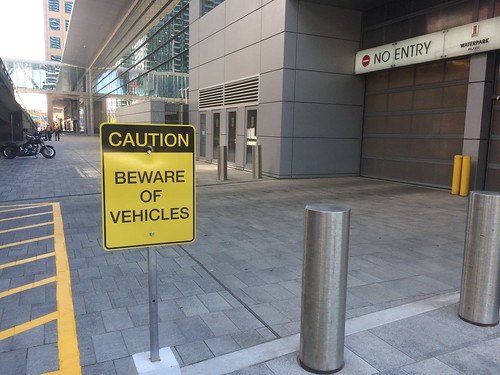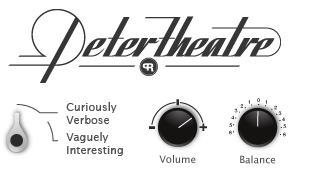Walk Away

This explains everything.
This morning’s discussion about Vision Zero in Toronto on CBC’s Metro Morning was surprising. I expected there to be questions about pedestrian behaviour. We live in a time when we’ve either walked into someone with their head down looking at their phone, or we’ve been that person (be honest with yourself). I expected there to be questions about intersections such as at Queens Quay and York Street where cyclists, ambling tourists, turning cars and streetcars converge and cross paths constantly. I expected there to be some comments on increasingly aggressive or distracted driving.
What I didn’t expect was this ongoing theme that people walking should watch where they are going and that in busy streets people should be more careful. The “on the street” segment immediately put people on the back foot. The rule about not starting crossing the intersection when the crosswalk countdown begins is so absurd, its very existence should indicate the major problems our streets have. At many intersections the actual time given to cross may be only 7 seconds compared to the 15 seconds of “countdown”. Yet, people want to get where they are going. If I see the countdown (it sounds more ominous the more I write it) at “5” at University and Richmond, don’t worry I’m not going to start. On the other hand if I have the foot speed of Andre De Grasse, the number might seem relative.
Let’s be clear. People on foot do not bump into cars and kill the driver. It is the other way around. Over 70% of pedestrian fatalities happened when the person was crossing the street lawfully. There have been three incidents this year when a car left the street and hit someone (in two of those cases a person, drove their vehicle into a building injuring those inside). So let’s start there. If you are in control of a device that may weigh 2000 - 3000 pounds, it is incumbent on you to not hit another person with it. That’s why you need a license to operate it. That means, when the light changes to amber, you slow down and stop. And you never go through a red light. But everyday we see the opposite. Drivers accelerate through the amber light and there is always someone who enters the intersection as the amber is changing to red and continues through. Everyday we see cars slow just enough to make the right hand turn but never actually stop on the red. How many times do you see a driver make a u-turn? Many times a day. How many times do you see a car turn to either change lanes or make a turn without using their signal light? Many times a day. How many times do you see a person drive up on the sidewalk? Many times a day. What strikes me as incredible is that people driving find it easier to hit the horn rather than hit the brake.
We’ve become so accustomed to bad driving habits that they’ve become the norm. In fact, it’s so normal, we’re telling people to get out of the way of any vehicle as if it is some kind of hurtling meteorite that can’t be stopped. Vehicles are driven by people. It’s not inevitable that the car won’t or can’t stop. All the driver has to do is decelerate. There’s even a pedal specifically for that purpose. But people in cars just don’t do it. Why? Because, encased in a steel and plastic container, looking at the world through a screen of glass dissociates the person driving from a person walking. That’s not a person walking across the street but an obstacle crossing your screen. It’s not a person, it’s just a moving blob without parents, without children, without lovers, without friends or siblings or other people who depend on them.
Traffic fatalities aren’t always caused by careless folks walking into traffic or even by distracted drivers. Many times it is systemic. That responsibility falls on the urban planners who encouraged offices and condos to be built between the fastest and busiest streets in the city, or the engineers who planned exit ramps or corners to allow vehicles to turn at high speeds or the architects and developers who designed delivery access to cross the busiest pedestrian throroughfare to a building. As a society we’ve put all other problems on the back burner so that a person driving a car isn’t inconvenienced. That’s the priority. That priority affects our roadways, our neighbourhoods, our architecture, our laws and our lives.
Even referring to traffic fatalities as “accidents” dissociates the person committing the act from the victim. An accident is an unforeseeable event. Someone getting hit by another person driving a car is so predictable we accept it as a fundamental part of driving. If you’ve ever been struck by another person driving or almost hit, it affects you far greater than the person in the car. Recently I was almost hit by a delivery van, not on the street, not at an intersection but on the sidewalk. What angered me the most was the complete indifference of the driver and of the building security who admonished me for being so angry. In my outburst I kicked over a sidewalk sign prohibiting smoking. One security guard confronted me saying, “What right do you have to destroy private property?” This drove me over the edge. What right do I have to kick over a private sign on a public property? I will tell you what right I have. The right to live and that right far outweighs anyone’s driving privileges. In the weeks after that confrontation a new sign appeared on the sidewalk, one alerting people walking to approaching vehicles. This sign is so backwards and upside down in every aspect it illustrates the ignorant attitude we have towards pedestrians. Well, guess what assholes, I don’t need reminding that incompetent individuals are nearly killing me everyday. I need people driving to realize the implications of their actions and to act accordingly.


0 Comments:
Post a Comment
<< Home